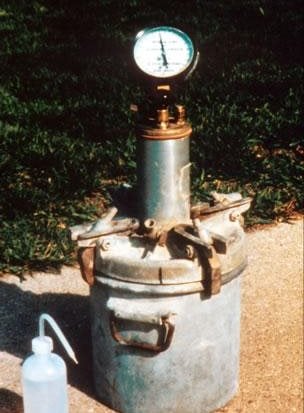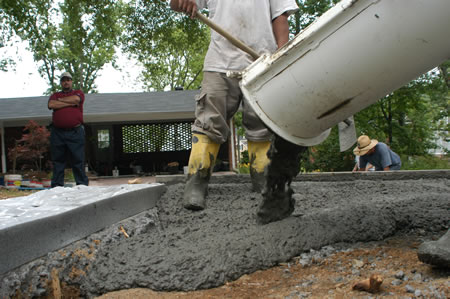How to Use Air Entrainers in Decorative Concrete
What is air-entrained concrete and why is it important in decorative work? Here’s all you need to know.Most specifications for exterior decorative concrete flatwork require air entrainment, which involves the use of an admixture to intentionally incorporate tiny air bubbles throughout the concrete matrix to improve its durability to freeze-thaw exposure. But despite its widespread use, many concrete contractors only have a vague understanding of what air entrainment actually entails. Does all exterior concrete require entrained air, and how does air entrainment impact the workability and performance of a concrete mix? More important, how much entrained air does your concrete need, and how do you test for air content to ensure that your mix meets project specifications?
Read on to get answers to these questions and more, plus learn why entrained air is often considered to be the fifth essential ingredient in many exterior concrete mixes.
What is air-entrained concrete?
Air-entrained concrete contains a network of microscopic air bubbles that help alleviate internal pressure on concrete caused by the expansion of water as it freezes. A single cubic foot of air-entrained concrete may contain billions of these air bubbles, and their presence can dramatically change the nature of both fresh and hardened concrete.
What Factors Impact Air Content in Concrete?
Time: 04:40
More air entraining videos from Fritz-Pak
Air is incorporated into concrete by the use of an air-entraining admixture (also called an air-entraining agent) that is added to the fresh concrete in controlled amounts, either at the batch plant or on the jobsite. The amount of air in a mix can be adjusted as needed to meet specific job requirements and exposure conditions.
What are the benefits of entrained air in concrete?
The primary benefit of entrained air is the resistance it gives hardened concrete to freeze-thaw damage and spalling caused by deicing salts or chemicals. However, air entrainment offers other advantages as well:
- It makes concrete more durable and reduces the potential for shrinkage and crack formation.
- In fresh concrete, entrained air acts as a lubricant, making concrete more plastic and easier to spread and finish.
- Air-entrained concrete tends to be more cohesive and uniform, resulting in a reduction in bleeding and segregation.
For more information about the benefits of air entrainment, see Protect Against Freeze-Thaw Cycles to Improve Durability.
What is the difference between air-entrained and non-air-entrained concrete?
Air-entrained concrete is made from the same four components used to manufacture conventional concrete: cement, coarse aggregate, fine aggregate (or sand), and water. The one difference is the addition of an air-entraining agent, sometimes considered to be the fifth essential ingredient in an exterior concrete mix.
Even when an air-entraining admixture isn’t used, concrete will contain a small percentage of air (about 1% to 2%) that is naturally entrapped within the concrete during mixing. These entrapped air bubbles are larger and more irregular in shape than entrained air bubbles and contribute nothing to concrete durability and freeze-thaw resistance. Entrapped air is also unstable and can be lost when the concrete is transported and placed.
Does all exterior concrete need an air-entraining admixture?
Air entrainment is a must for exterior concrete in areas of the country where frost-related damage can occur. It is especially essential for concrete driveways that will be exposed to vehicle traffic and deicing salts (see The Correct Concrete Driveway Mix). Because entrained air is beneficial to concrete in so many ways, it’s often recommended for exterior concrete in mild climates as well, even if there’s little concern about freezing and thawing.
Is air-entrained concrete harder to place and finish?
There are no major differences between handling and placing of air-entrained concrete vs. non-air- entrained concrete, and many contractors will tell you that air-entrained concrete is easier to work with. However, you may need to adjust your normal finishing operations because air entrainment can significantly reduce bleeding of the concrete. That means floating and troweling may need to be completed sooner before the concrete surface becomes too stiff, especially on hot and windy days when moisture evaporates quickly.
 NCA (Non-Chloride Accelerator)
All weather admixture
NCA (Non-Chloride Accelerator)
All weather admixture
 Rescue-Pak
Contains six of our most effective admixtures
Rescue-Pak
Contains six of our most effective admixtures
 Standard Delayed Set
Dry Powdered Admixture
Standard Delayed Set
Dry Powdered Admixture
How much air entrainment do I need?
The industry standard for entrained air content in exterior concrete flatwork subject to freeze-thaw cycles and exposure to deicing chemicals is 6%, per ASTM C260, Standard Specifications for Air Content in Concrete. But a leeway of +2% is permitted to account for variables such as concrete material proportions, mixing methods, and the temperature of the concrete, all of which can cause fluctuations in air content.
An exception to this 6% rule is decorative stamped concrete. Because entrained air can reduce bleed water, which is needed to wet out the color hardener, a 4% air content is often recommended (see Stamped Concrete Mix Recipe). Anything less than 4% will not give concrete the durability needed to hold up to repeated freeze-thaw exposure.

A Type B pressure meter is used to determine the air content of normal-weight concrete. The air content is read at the dial, which is calibrated for each apparatus. The aggregate correction factor (explained in ASTM C 231) must be subtracted from your reading to obtain the net air content. (Photo courtesy of PCA.
How do I test for air content?
Testing the air content of fresh concrete at the jobsite is essential, since an entrained air content higher or lower than specified can have a negative effect on concrete performance. Too much entrained air can cause a loss of compressive strength and stickiness during finishing, while too little will compromise concrete durability.
There are a number of methods that can be used to test for the air content of concrete, but a pressure meter is often preferred because it provides fast, reliable results, often within 10 to 15 minutes (see Testing Air Content in Concrete).
What happens if the air content is too low?
If the ready-mix truck arrives at the job and an air content test determines that the percentage of air is lower than specified, all is not lost. Rather than rejecting the concrete and sending the truck back, it’s possible to make corrections in the field by using a premeasured, prepackaged air-entraining admixture (such as Fritz-Pak’s Air Plus) that you can add directly to the truck mixer. One bag will increase the entrained air content of a full load of concrete by as much as 1%.
What are the consequences of not using air entrainment in decorative concrete?
No or low air entrainment in exterior concrete exposed to freeze-thaw conditions will result in poor durability and much greater vulnerability to the internal pressures caused when moisture in concrete freezes and expands. The consequences of freeze-thaw damage can be particularly devastating to the appearance of stamped concrete. They include ugly scaling and flaking of the surface, popouts, and cracking, all of which may continue to worsen with successive freeze-thaw cycles. Even if the concrete has a dense color-hardened surface and is protected by a good sealer, it can still sustain damage if it becomes saturated and freezes.
The simplest way to avoid these problems is to add an air-entraining admixture to your concrete mix. Depending on the exposure conditions in your area, you should aim for an air content of about 4% to 7%, or as recommended by your ready-mix supplier.






